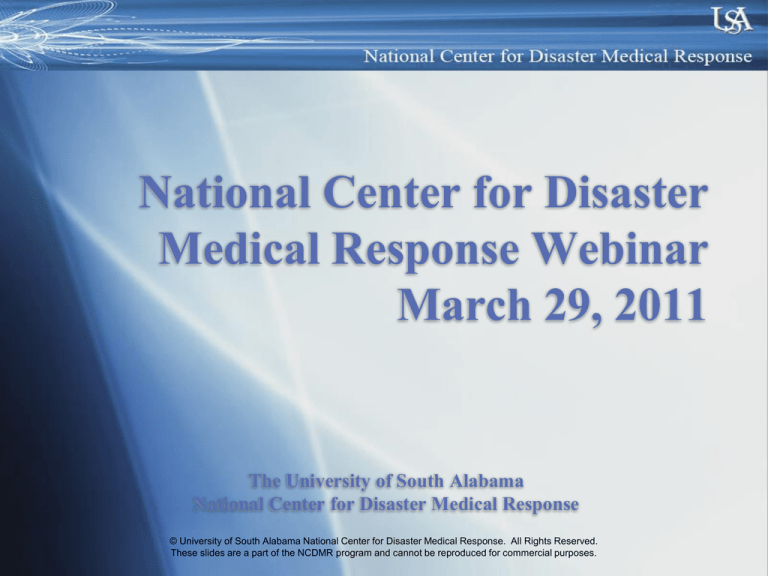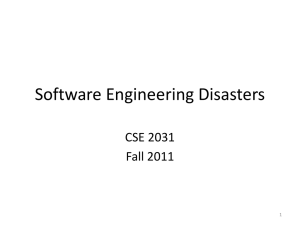
National Center for Disaster
Medical Response Webinar
March 29, 2011
The University of South Alabama
National Center for Disaster Medical Response
© University of South Alabama National Center for Disaster Medical Response. All Rights Reserved.
These slides are a part of the NCDMR program and cannot be reproduced for commercial purposes.
Presenters
Surge Capability in Complex Disasters
Carl Taylor, JD
Assistant Dean, USA College of Medicine
Director, USA Center for Strategic Health Innovation
Mobile, Alabama
Introduction to Radiological Agents
Craig Llewellyn, MD, MPH
Colonel, U.S. Army (Retired)
Center for Disaster and Humanitarian Assistance Medicine
Bethesda, Maryland
Meeting Mental Health Needs During and After Disasters
Carolyn Ross, RN, MSN, COHN-S
Assistant Director, Preparedness Training
USA Center for Strategic Health Innovation
Mobile, Alabama
Building Resiliency:
Meeting Mental Health Needs
During and After Disaster Events
The University of South Alabama
National Center for Disaster Medical Response
© University of South Alabama National Center for Disaster Medical Response. All Rights Reserved.
These slides are a part of the NCDMR program and cannot be reproduced for commercial purposes.
Introduction
Every affected individual will react and cope
with disaster and traumatic events with varying
skills and strengths based on their life experiences,
values, beliefs, cultural viewpoints, socio-economic
status and intellectual capability.
Normal and Abnormal
Stress Reactions
Positive Stress
‘Fight or Flight’ response
is a physiological
response which ensures
safety and survival
during extreme events:
Negative Stress
When stress reaction is
prevalent for a long
period of time or if it is
unresolved damage the
physical and mental
health of individuals.
Significant Traumatic
Events
Natural Disasters
Terrorism Events
Violent Events (such as war or civil unrest)
Small or large scale personal trauma, loss or
emergency
Any type of disaster or traumatic event which can
cause fear, trauma or loss
Disaster Phases and
Response
Warning and threat
Impact
Rescue or heroic
Remedy or honeymoon
Inventory
Disillusionment
Reconstruction and Recovery
Building Psychological
Resiliency During and After
Disasters
Mental health education and interventions will
be necessary for the following targeted groups:
Population of Affected Community
Responders
In-situ (hospital personnel, emergency responders)
Deployed disaster and emergency responders
Key Concepts of Disaster
Mental Health
Everyone who experiences
a disaster will be touched
by it!
People generally will
pull together during
and after a disaster
There are 2 types of
disasters: individual
and community
Stress and grief in
disasters are
normal reactions
to abnormal
situations
Most people
feel they do
not need
mental health
services
Use an active
outreach approach
instead of
traditional methods
Social Support
systems are crucial
to recovery!
Survivors
respond to
active genuine
interest and
concern
Signs and Symptoms of Short
and Long Term Reactions to
Stress/Trauma
Symptoms of Short Term Negative
Stress
Common Symptoms Short &
Chronic Term
•
•
•
• Feeling depressed, helpless, sad and
Inability to concentrate
Changes in eating and sleeping habits
Tension headaches, lower backaches,
stomach aches, and other physical
ailments
Disaster
Trauma Event
lethargic
•Memory problems
•Fatigue
•Feeling angry, irritable, lashing out
at others
•Symptoms of PTSD/Chronic Stress
Symptoms of PTSD/Chronic Stress
•Nightmares related to event
•Sleep disturbances
•Changes in appetite
•Situational anxiety and fear
•Being on ‘edge’ or easily startled or being
‘over alert’
•Inability to focus on work or daily activities
•Difficulty in making decisions
•Feeling emotionally numb, withdrawn,
disconnected or different from others
•Spontaneously crying, feeling a sense
of despair and hopelessness
•Feeling extremely protective or fearful
for the safety of loved ones
•Not being able to face certain aspects of
the trauma and avoiding activities,
places or even people that remind you of
the events
Interventions
Individuals/Responders
Community
CISD (Critical Incident Stress
Debriefing)
Recognize importance of culture and
respect diversity
Adequate rest, nutrition and
exercise
Recruit disaster workers, community
leaders and organizations who are
representative of community
Return to normal routines
Ensure that services are accessible,
appropriate and equitable
Focus on pleasant memories
and use relaxation techniques
Participate in a support group
or seek counseling
Keep a journal
Recognize cultural patterns that may
influence help seeking behaviors
Ensure that services and information
are cultural and linguistically
competent
Conclusion
Immediate Interventions and Preventive
Planning are key to successful interventions!
Develop Stress Management programs to
implement in order to effectively manage
stress!
Questions?
Introduction to Radiological
Agent Awareness
The University of South Alabama
National Center for Disaster Medical Response
© University of South Alabama National Center for Disaster Medical Response. All Rights Reserved.
These slides are a part of the NCDMR program and cannot be reproduced for commercial purposes.
Toxicity Basics:
Chemical or Radiological
Substances
Specific health effect characteristics of agent/chemical (localized versus
systemic)
Mode of entry (skin, lungs, eyes, GI tract)
Dose (how much, what concentration)
Duration of Exposure (how long)
Stress (anything that increases the heart rate can increase systemic absorption)
Personal physical condition (sick, anemic, impaired skin integrity,
drug/alcohol consumption)
Radiological Event:
The higher the probability for an
incident, the lower the expected #’s
of casualties.
Most Probable Incident Types:
Radiological:
- Industry, medicine, research, teaching
or agriculture
- Radioactive material or devices
generating ionizing radiation
Nuclear accidents:
- nuclear facilities
Accident
Terrorists
Single Detonation
Isolated Nuclear
Conflict
Worldwide Nuclear
Conflict
Comparison of Radiation
Categories
Alpha
Beta (β-) or
Gamma
•Two protons and two
neutrons bound together
• Very high energy levels,
highly ionizing
• Protection with
STANDARD PPE
- low penetration
(paper & cloth
adequate barriers)
- short travel distance centimeters (heavy)
• Hazards: ingestion or
inhalation
- deposits in organs
- immediate damage
and ongoing chronic
exposure risk
• Single electrons or positrons
•Electromagnetic radiation
(pass through)
• Varying energy levels and
speed
• Standard/Special PPE
provides NO protection
- high penetration, travels
long distances
- Time/Distance/
Shielding until gamma
rays pass- concrete,
steel dense barriers,
lead
• Hazard: ionizing
penetrating rays
- Immediate damage,
ends when rays pass
• High energy, high speed
• SPECIAL PPE required
- Travel distance – 10-15 feet
lighter weight
- Penetrates skin- metal,
plastic, glass are adequate
barriers
• Hazards: Contact, inhalation,
ingestion
- Skin and eyes- burning w/
high levels
- Deposits in organskidneys, liver, lungs, bone
- Immediate and chronic
exposure risk
Radiological Event
PPE, Contamination Patterns
and Decontamination
Personal Protective
Equipment
Radiological
Contamination –
Internal/External
Decontamination
Particulate Radiation Exposure
•Contact, Inhalation, Ingestion
Risk
•A high efficiency particulate
air (HEPA) filter
•Standard universal
precautions clothing or
chemical suits (gown/suit,
gloves, goggles)
To determine radiation exposures
check individuals with a Geiger
Counter or other reputable
radiation measurement devices:
• Note: Decontamination is 95%
effective in contaminant
removal
Electromagnetic Radiation
Exposure
•No PPE needed after gamma
rays pass
- Before disrobement and
decontamination
- After decontamination
• Wet patient down to reduce
airborne particles
• Remove clothing… even
underwear!!
• Do not remove clothing over
head!
• Flush with large amounts of water
(Soap and water to remove from
skin and hair.)
•Measure residual radiation with a
Geiger Counter
•Re-dress
Patterns of Radiological
Contamination
Important: Geiger Counter should be used to measure for radioactivity:
•Scan body – front and back in systematic way
•Before decontamination
•After decontamination
Internal
External
Suspect Internal Radiation:
- If Geiger Counter readings are the
same on the front and back of person
after decontamination
- If swab from nasal turbinates is
positive for radioactivity
Suspect External Radiation Only:
- If Geiger counter shows no activity
after person has disrobed and been
decontaminated
*** Observe closely for systemic effects of
radiation syndrome
- If Geiger Counter registers positive
only
on front OR back of body (One side of
the body)
Acute Radiation Syndrome
2.5 - 5 Gy (250- 500 RAD)
Survival Possible Treatment
for Infections, Fluids, Blood
System is Necessary
1-2.5 Gy (100-250 RAD)
Survival Probable Treatment
for Infections, Fluids, Blood
System PRN
> 5 Gy (500 RAD)
Survival Unlikely
Supportive Care with
Fluids and Electrolytes
< 1 Gy (100 RAD)
Survival Fairly Certain
No Treatment
Necessary
0 RAD
> 500 RAD
Increasing Dose
Radiation Symptoms
Hematopoietic Disorders
•Anemia
•Bleeding
•Infections
•Delayed healing
Neurovascular Symptoms
•Burning sensations
•Poor balance
•Confusion
Gastrointestinal Symptoms
•Nausea/Vomiting **
•Diarrhea
•Mouth / Throat Sores
•↓ Appetite & Weight Loss
Cutaneous Tissue Symptoms
•Burns, blistering
•Skin sloughing
•Hair Loss
Health Effects from
High Radiation
Exposure
Sources: Environmental Protection Agency, Nuclear Regulatory Commission,: U.N. Scientific Committee on the Effects of Atomic Radiation:
Canadian Nuclear Association.
New York Times , March 27, 2011
Questions?
Surge Capability In Complex Disasters
The University of South Alabama
National Center for Disaster Medical Response
© University of South Alabama National Center for Disaster Medical Response. All Rights Reserved.
These slides are a part of the NCDMR program and cannot be reproduced for commercial purposes.
What is Surge
Capacity?
The ability of a healthcare system to rapidly
expand beyond normal services to meet sudden or
sustained increased demand for medical care.
Surge Capacity vs.
Capability
Surge Capacity:
The ability to evaluate and care for a markedly
increased volume of patients - one that challenges or
exceeds normal operating capacity.
Surge Capability:
The ability to manage patients requiring unusual or very
specialized medical evaluation and care, e.g., infectious
disease or burn patients.
Key Principle
We will work to maximize lives saved,
which must include our staff and our
patients
Planning For A Surge
Surge conditions may last for months
not just days
Your other patients have needs also
The usual scope of practice may not
apply
External events will impact internal
response
Planning Continued
The time of day or month may matter
Communication both internal and external
may be challenged
Staff challenges will create the need for
flexibility both during and after the event
Planning Continued
Some staff may not be yours
Supplies and supply chain disruption may
occur
Transportation and Fuel issues are
problematic
Alternate facilities and COOP planning a
new challenge
Planning Final
Leadership at every level will matter
Security of staff, patients and facility is
paramount
Cash and Financial Management may be
more damaging to the facility than wind
and water
There is no one size fits all response- the
nature of the event matters
Important Issues
Do we know our communities health?
Can we communicate with public health
and disaster leadership?
Who is making the decisions during a
disaster (and can we count on them)?
When we need help where does it come
from and do we know how to access it?
Resource and Contact
Information
National Center for Disaster Medical Response
Website:
www.ncdmr.org/
Contact Information:
Carl Taylor
Carolyn Ross
email: cwtaylor1@gmail.com
email: carolynross@usouthal.edu
Questions?








